Imagine the delight of your guests as they gather around a beautifully arranged Italian charcuterie board, savoring the rich flavors of prosciutto, the creamy indulgence of gorgonzola, and the vibrant crunch of marinated olives. Italian charcuterie boards are not just a feast for the palate, but also a visual celebration of Italy's rich culinary heritage. Whether you're planning a casual get-together or a sophisticated soirée, this guide will help you create a charcuterie board that is sure to impress, combining traditional elements with creative touches for a truly unforgettable experience. Let's dive into the art of crafting the perfect Italian charcuterie board, one delectable component at a time.
TIP: Fast-track your charcuterie skills and connect with 514K experts. Click for instant access to our comprehensive guide and community >>
Table of Contents [CLICK HERE TO OPEN]
- The Essential Components of an Italian Charcuterie Board
- How to Make an Italian Charcuterie Board
- Perfect Pairings: Wine and Beverages for Italian Charcuterie
- Italian Charcuterie Board Ideas and Variations
- Complementary Italian Appetizers and Snacks
- Frequently Asked Questions about Italian Charcuterie Boards
- Wrapping It Up
- People Also Asked
The Essential Components of an Italian Charcuterie Board
Creating an Italian charcuterie board involves a careful selection of meats, cheeses, and accompaniments that reflect Italy’s rich culinary heritage. Here’s a detailed look at each essential component:
Italian Meats: A Delectable Selection
Prosciutto Prosciutto is a dry-cured ham that is thinly sliced and served uncooked. Originating from regions like Parma and San Daniele, it’s known for its delicate, sweet, and salty flavor. The aging process, which can last from 9 to 24 months, enhances its rich, melt-in-your-mouth texture. Prosciutto pairs excellently with fruits like melon or figs, and a glass of crisp white wine.
Salami Salami is a versatile cured sausage made from ground pork and seasoned with various spices. Italian varieties include Salami Milano, known for its mild flavor and fine texture, and Salami Napoli, which is spicier with a coarser grind. Salami adds a robust, savory element to the charcuterie board and complements both cheeses and pickled vegetables.
Mortadella Mortadella is a large, round sausage made from finely ground pork, studded with cubes of pork fat and flavored with spices like black pepper. Originating from Bologna, it’s smooth and slightly sweet with a rich, fatty texture. Mortadella is often enjoyed on its own or paired with crusty bread and mild cheeses.
Coppa Coppa, also known as capicola, is a dry-cured pork shoulder or neck that is seasoned with a mixture of spices and aged to develop a complex, aromatic flavor. Its rich, fatty texture and spicy notes make it a standout on any charcuterie board, especially when paired with a full-bodied red wine.
Bresaola Bresaola is an air-dried, salted beef that is aged for several months. It originates from the Lombardy region and has a deep red color with a tender, lean texture. Bresaola is typically served thinly sliced and is often garnished with a drizzle of olive oil and a squeeze of lemon juice. It pairs well with fresh arugula and shaved Parmesan.
Italian Cheeses: Perfect Pairings
Parmesan Parmesan, or Parmigiano-Reggiano, is a hard, granular cheese known for its sharp, nutty flavor and crystalline texture. Aged for at least 12 months, it adds a savory depth to the charcuterie board. It’s perfect for grating over dishes or enjoying in chunks with a drizzle of balsamic vinegar.
Pecorino Pecorino is a family of Italian cheeses made from sheep’s milk. Pecorino Romano is the most well-known variety, with a sharp, salty taste and firm texture. It contrasts beautifully with the rich flavors of cured meats and is excellent when paired with fresh fruits or honey.
Gorgonzola Gorgonzola is a blue cheese with a creamy, tangy flavor and veined blue mold. It comes in two varieties: Gorgonzola Dolce (mild and creamy) and Gorgonzola Piccante (stronger and crumbly). It adds a bold, tangy note to the board and pairs well with honey or fruit preserves.
Asiago Asiago is a semi-hard cheese with a flavor that ranges from mild to sharp depending on its aging. Asiago Pressato (fresh) is smooth and creamy, while Asiago Stravecchio (aged) is more crumbly and sharp. It complements both the sweetness of fruits and the savory notes of cured meats.
Mozzarella Mozzarella is a soft, mild cheese that is often served fresh and can come in various forms, including buffalo milk and cow’s milk. Its delicate flavor and creamy texture make it a versatile addition, perfect when paired with tomatoes, fresh basil, or a drizzle of olive oil.
Delicious Accompaniments: Enhancing the Experience
Olives Olives add a briny, tangy element to the charcuterie board. Italian varieties include Castelvetrano, which is sweet and mild, and Gaeta, which is dark and tangy. They are a great complement to both cheeses and meats, adding a burst of flavor and texture.
Marinated Vegetables Marinated vegetables like artichokes, roasted red peppers, and mushrooms add a zesty, tangy contrast to the rich flavors of cured meats and cheeses. They often come in a variety of marinades, including vinegar-based or oil-based, enhancing the overall taste profile of the board.
Fresh and Dried Fruits Fresh fruits such as grapes, figs, and apples offer a sweet contrast to savory elements. Dried fruits like apricots and dates provide a chewy, concentrated sweetness that pairs well with cheeses and meats. They add color and variety to the board.
Nuts Nuts such as almonds, walnuts, and pistachios provide a crunchy texture and a nutty flavor that complements both the meats and cheeses. They also add a satisfying bite and can be lightly salted or roasted for extra flavor.
Bread and Crackers A selection of crusty breads and crispy crackers serves as the perfect vehicle for enjoying cheeses and spreads. Options include ciabatta, baguette slices, and an assortment of artisanal crackers, providing a range of textures and flavors.
Specialty Items for an Authentic Touch
Truffle Products Truffle products like truffle oil or truffle-infused salts add a luxurious, earthy aroma to the board. Truffles are a prized ingredient in Italian cuisine, and their distinctive flavor enhances both cheeses and meats, making the board feel more gourmet.
Balsamic Glaze Balsamic glaze is a reduced balsamic vinegar with a sweet and tangy flavor. Drizzling it over cheeses, fruits, or even meats adds a depth of flavor and a touch of elegance. It can also be used as a dip for bread.
Artisanal Spreads and Preserves Artisanal spreads and preserves, such as fig jam, honey, and olive tapenade, offer unique flavor profiles that enhance the charcuterie experience. They pair beautifully with cheeses and meats, providing additional layers of taste and texture.
This comprehensive selection of meats, cheeses, and accompaniments ensures a well-rounded and satisfying Italian charcuterie board that will delight any guest.

How to Make an Italian Charcuterie Board
Creating a stunning Italian charcuterie board is both an art and a science, involving thoughtful selection, arrangement, and presentation. Here’s a detailed step-by-step guide to help you craft the perfect charcuterie board:
Step-by-Step Guide to Assembly
1. Selecting the Right Board and Utensils
- Board: Choose a large, flat surface such as a wooden cutting board, marble slab, or a large serving platter. The board should be spacious enough to accommodate all your components while allowing room for easy access and arrangement.
- Utensils: Equip yourself with a variety of utensils, including cheese knives, spreaders, tongs, and small spoons. Each cheese and spread may require its own knife to avoid mixing flavors.
2. Arranging Meats and Cheeses
- Meats: Start by placing your cured meats on the board. Arrange them in clusters or fanned out to create visual interest. For items like prosciutto, fold or roll the slices for a more elegant presentation.
- Cheeses: Place your cheeses around the board, ensuring they are spaced out to avoid crowding. Use different knives for each cheese to preserve their distinct flavors. Consider arranging cheeses from mild to strong in terms of flavor.
3. Adding Accompaniments and Garnishes
- Accompaniments: Fill in the spaces around the meats and cheeses with your accompaniments such as olives, marinated vegetables, nuts, and fruits. This not only adds flavor but also enhances the visual appeal of the board.
- Garnishes: Add small garnishes like fresh herbs, edible flowers, or a drizzle of balsamic glaze to provide a finishing touch and elevate the presentation.
Creative Presentation Ideas
1. Themed Arrangements (Seasonal, Regional)
- Seasonal Boards: Tailor your board to the season by incorporating seasonal fruits, nuts, and herbs. For example, use figs and pomegranates in the fall, or berries and fresh basil in the summer.
- Regional Boards: Create a regional theme by focusing on specific Italian regions. For instance, a Tuscan board might feature Chianti wine, Pecorino cheese, and cured meats from Tuscany, while a Sicilian board could include local olives, citrus fruits, and a variety of Sicilian salamis.
2. Tips for Achieving a Balanced and Visually Appealing Board
- Color and Texture: Aim for a balance of colors and textures. Combine creamy cheeses with crunchy nuts, and colorful fruits with dark meats to create a visually stimulating board.
- Shapes and Sizes: Vary the shapes and sizes of your components. Cut cheeses into wedges or cubes, fold or roll meats, and place nuts and fruits in small clusters.
- Spacing: Ensure there is ample space between items to allow for easy serving and to highlight each component’s individual qualities.
Practical Tips for Serving
1. Maintaining Freshness
- Chilling: Keep the charcuterie board chilled until serving, especially if it includes items like fresh mozzarella or meats. If serving outdoors, consider using a chilled serving tray or platter.
- Covering: Cover the board with plastic wrap if it will be sitting out for a while before serving to prevent the ingredients from drying out.
2. Serving Temperatures
- Cheeses and Meats: Serve cheeses and cured meats at room temperature to enhance their flavors and textures. Take them out of the refrigerator about 30 minutes before serving.
- Accompaniments: Keep accompaniments like olives and marinated vegetables at room temperature unless otherwise specified.
3. Portion Recommendations
- Serving Size: Plan for about 2-3 ounces of meat and 1-2 ounces of cheese per person, along with a generous amount of accompaniments. Adjust quantities based on the number of guests and the overall size of your board.
With these tips and techniques, you'll be able to assemble an Italian charcuterie board that is not only delicious but also beautifully presented, making it a centerpiece for any gathering.
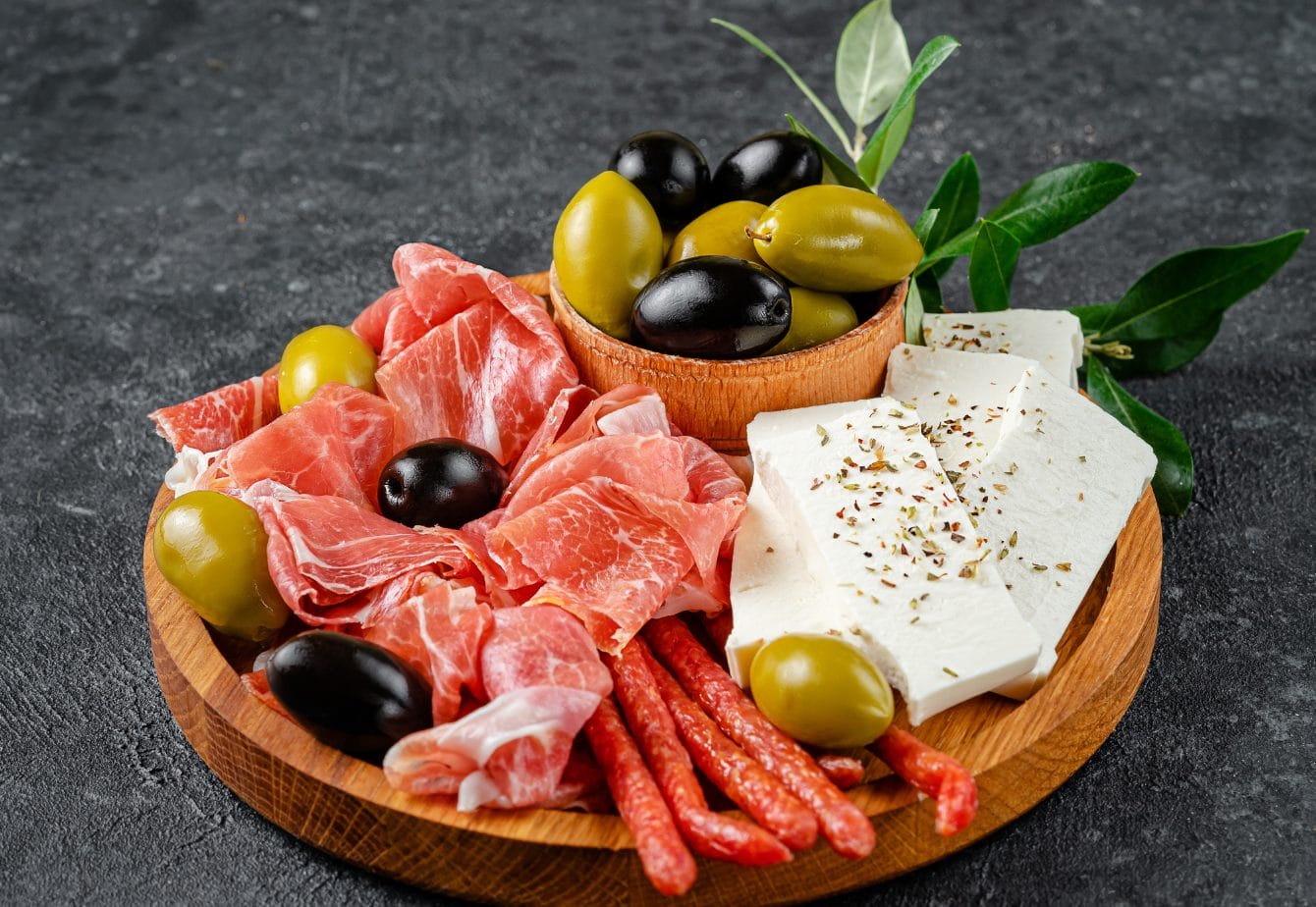
Perfect Pairings: Wine and Beverages for Italian Charcuterie
Pairing beverages with your Italian charcuterie board can elevate the experience, enhancing the flavors of both the food and the drinks. Here’s a guide to selecting the ideal wines and other beverages to complement your charcuterie board:
Wine Pairings to Elevate Your Board
1. Red Wines
- Chianti: Chianti is a classic Italian red wine with bright acidity and flavors of cherry and earthy notes. It pairs exceptionally well with aged cheeses like Parmesan and cured meats like salami, complementing their rich flavors and balancing the board’s saltiness.
- Barbera: Barbera is a versatile red wine with high acidity and flavors of dark fruit and spice. It’s an excellent match for a range of Italian meats and cheeses, including sharper cheeses like Pecorino and rich meats like coppa.
2. White Wines
- Pinot Grigio: Pinot Grigio is a light and crisp white wine with notes of green apple and citrus. Its refreshing qualities make it a great match for milder cheeses like Mozzarella and lighter cured meats like prosciutto, providing a clean contrast.
- Vermentino: Vermentino offers bright acidity and flavors of citrus and herbs. It pairs well with a variety of cheeses and meats, particularly those with herbaceous or earthy notes, such as Gorgonzola and marinated vegetables.
3. Sparkling Wines
- Prosecco: Prosecco is a popular Italian sparkling wine with fruity and floral notes and a light, effervescent quality. It’s a fantastic complement to a wide range of charcuterie board components, especially salty meats and creamy cheeses.
- Franciacorta: Franciacorta is a high-quality sparkling wine made in the traditional method, similar to Champagne. It has complex flavors and a crisp finish that pairs beautifully with rich cheeses and savory cured meats.
Other Beverages to Consider
1. Italian Beers
- Peroni: Peroni is a well-known Italian lager with a crisp, clean taste. Its light and refreshing nature pairs well with a variety of meats and cheeses, making it a versatile option for any charcuterie board.
- Moretti: Moretti is another popular Italian beer with a slightly malty and hoppy flavor. It complements richer meats and cheeses, adding a pleasant bitterness that balances the board’s flavors.
2. Non-Alcoholic Options
- Sparkling Water: Sparkling water is a great non-alcoholic option that provides a refreshing contrast to the rich and savory elements of a charcuterie board. Opt for a high-quality brand with fine bubbles and minimal mineral flavor.
- Italian Sodas: Italian sodas, such as San Pellegrino, offer a range of flavors including blood orange, lemon, and grapefruit. These can add a fruity and slightly sweet touch to your charcuterie experience.
3. Aperitifs and Digestifs
- Aperol Spritz: The Aperol Spritz is a popular Italian cocktail made with Aperol, Prosecco, and a splash of soda water. Its bittersweet flavor and refreshing bubbles make it a great aperitif before diving into the charcuterie board.
- Limoncello: Limoncello is a traditional Italian lemon liqueur that can be served as a digestif after the meal. Its bright and zesty flavor provides a refreshing end to the charcuterie experience.
By pairing your Italian charcuterie board with the right wines and beverages and considering different thematic ideas, you can enhance the dining experience and create a memorable presentation that caters to a range of tastes and preferences.
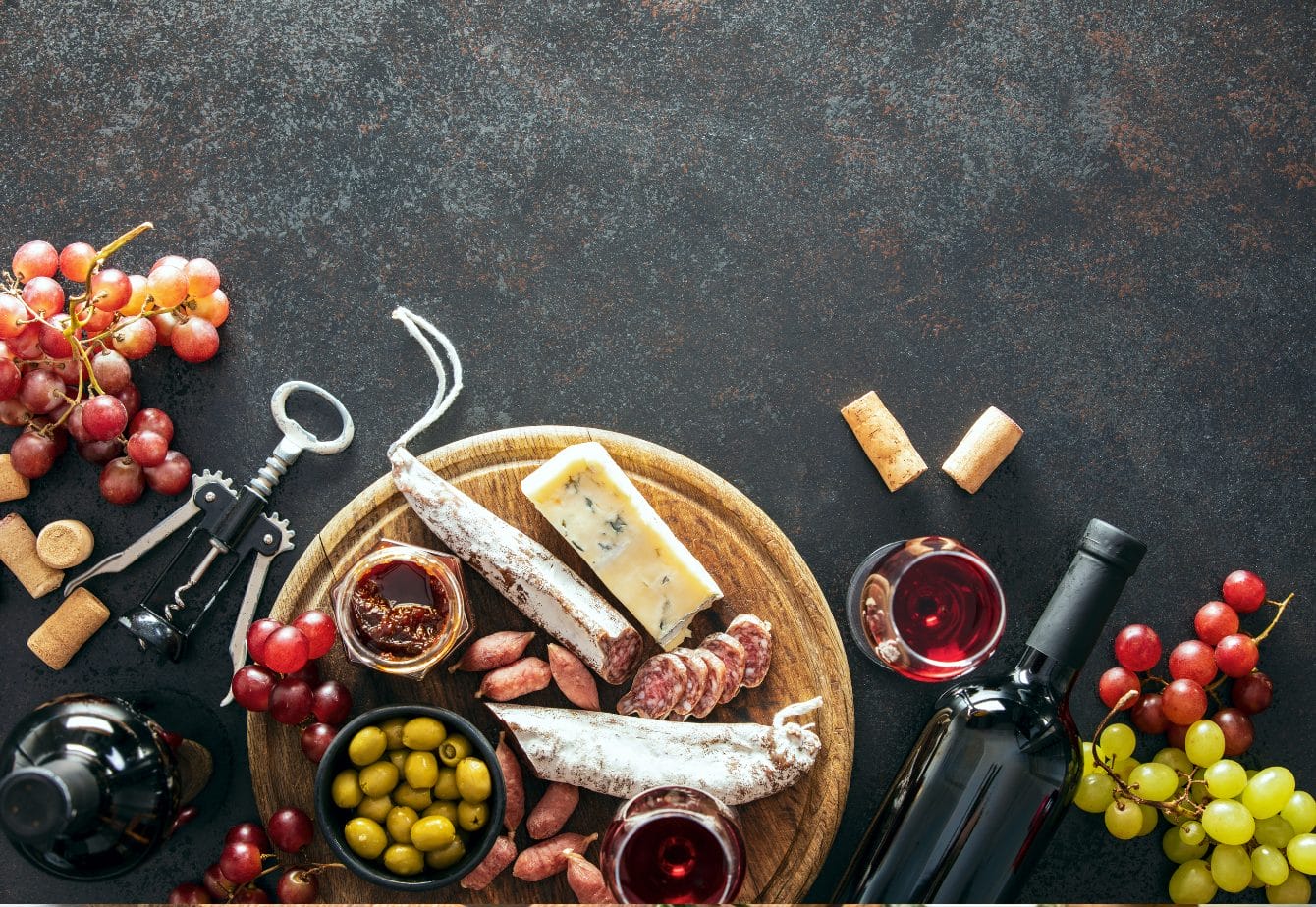
Italian Charcuterie Board Ideas and Variations
Creating an Italian charcuterie board can be adapted to suit various themes and preferences, ensuring that every gathering is memorable and enjoyable. Here are some creative ideas and variations to inspire your next charcuterie spread:
Themed Boards for Every Occasion
1. Regional Italian Boards
- Tuscan Board: Highlight the flavors of Tuscany with a selection of Chianti wine, aged Pecorino cheese, and cured meats like Finocchiona (fennel salami). Add marinated olives, fresh figs, and Tuscan bread to complete the experience.
- Sicilian Board: Showcase Sicilian specialties with local salamis, sharp Pecorino Siciliano, and an assortment of olives and citrus fruits. Include a touch of Sicilian sweets like cannoli or pistachio nuts for added flair.
2. Seasonal Boards
- Spring Board: Focus on fresh, light ingredients such as artichokes, asparagus, and young cheeses like Ricotta. Complement with fresh fruits like strawberries and citrus, and a refreshing white wine like Pinot Grigio.
- Fall Board: Embrace autumn flavors with seasonal ingredients like figs, apples, and spiced nuts. Include rich cheeses like Asiago and hearty cured meats such as Soppressata. Pair with a robust red wine like Barbera.
3. Holiday-Themed Boards
- Christmas Board: Create a festive board with red and green elements such as roasted red peppers, green olives, and seasonal fruits like pomegranates. Add rich cheeses like Gorgonzola and meats such as Prosciutto di Parma. Decorate with sprigs of rosemary and holly for a holiday touch.
- Easter Board: Incorporate springtime ingredients such as fresh herbs, radishes, and soft cheeses like Burrata. Add light, floral touches like edible flowers and fresh strawberries, and pair with a crisp Prosecco.
Vegetarian and Gourmet Options
1. Incorporating Vegetarian Alternatives
- Cheese Selection: Include a variety of artisanal cheeses such as Burrata, fresh Mozzarella, and aged Parmesan. Add vegetarian-friendly accompaniments like marinated artichokes, roasted peppers, and a selection of nuts.
- Non-Meat Proteins: Include plant-based options like chickpea hummus or lentil spreads. Add colorful fresh vegetables and fruits to complement the cheeses and spreads.
2. Luxury Ingredients and Upscale Presentations
- Truffle Products: Incorporate truffle-infused oils, truffle salt, or even truffle cheese to add a touch of luxury. These ingredients enhance the flavor profile and create a high-end charcuterie experience.
- Artisanal Items: Choose premium, artisanal bread, gourmet olives, and high-quality cured meats. Present the board on a marble or wooden platter for an elegant touch, and use decorative elements like gold leaf or edible flowers for added sophistication.
Kid-Friendly Charcuterie Boards
1. Simplified Versions for Younger Palates
- Milder Cheeses: Use kid-friendly cheeses such as Cheddar, Mozzarella, and mild Gouda. Include simple meats like turkey slices or mild ham.
- Fruits and Vegetables: Add colorful, bite-sized fruits such as apple slices, grapes, and carrot sticks. Include simple crackers and breadsticks for a familiar and approachable snack.
2. Fun and Engaging Arrangements
- Themed Shapes: Arrange items in fun shapes or create themed arrangements like a smiley face or animal shapes using cheese and fruits. Use cookie cutters to create playful designs with fruits and cheeses.
- Interactive Elements: Include a “build-your-own” section with mini wraps or sandwich components, where kids can assemble their own snacks using the ingredients provided.
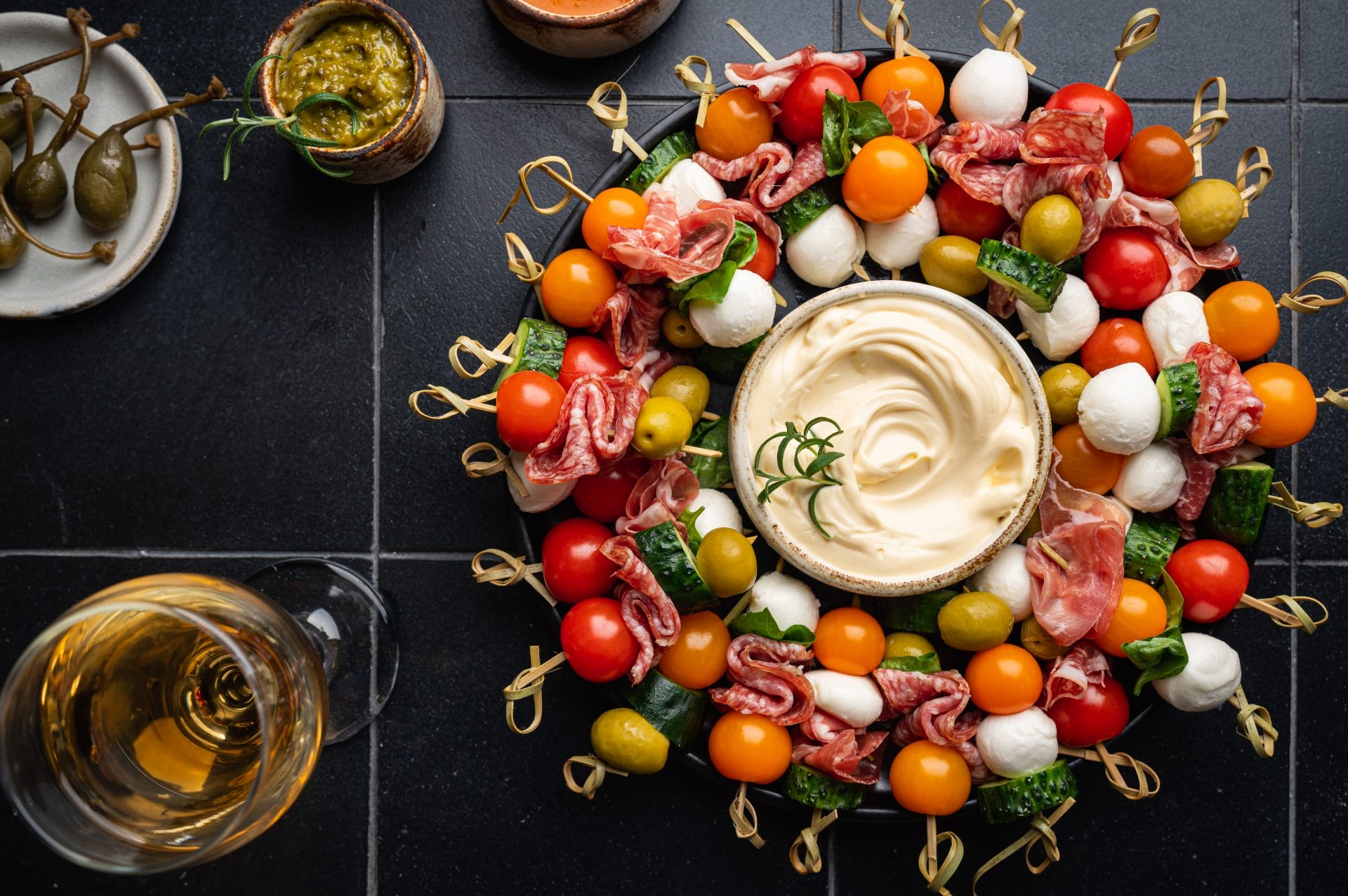
Complementary Italian Appetizers and Snacks
Complementary Italian Appetizers and Snacks
1. Traditional Italian Appetizers
- Bruschetta: Toasted bread slices topped with a mixture of diced tomatoes, basil, garlic, and olive oil. This classic appetizer adds freshness and complements the flavors of your charcuterie board.
- Caprese Salad: A simple salad of fresh tomatoes, mozzarella, basil, and a drizzle of balsamic glaze. It offers a light, refreshing contrast to the rich flavors of cured meats and cheeses.
- Antipasto Salad: A hearty salad featuring a mix of marinated vegetables, olives, cured meats, and cheeses. It’s a great way to offer a more substantial, savory option alongside your charcuterie board.
2. Italian Snack Ideas
- Crostini: Small, toasted bread slices topped with a variety of spreads like tapenade, goat cheese, or roasted red peppers. They make perfect bite-sized additions to your charcuterie board.
- Arancini: These are crispy, stuffed rice balls typically filled with cheese or meat. They add a savory, indulgent element that pairs well with both cheeses and wines.
- Stuffed Peppers: Mini bell peppers stuffed with a mixture of cheese, herbs, or grains. They offer a colorful and flavorful addition to your charcuterie spread.
These ideas and variations will help you create a diverse and engaging Italian charcuterie board that caters to different tastes and occasions, ensuring that your presentation is both delicious and memorable.
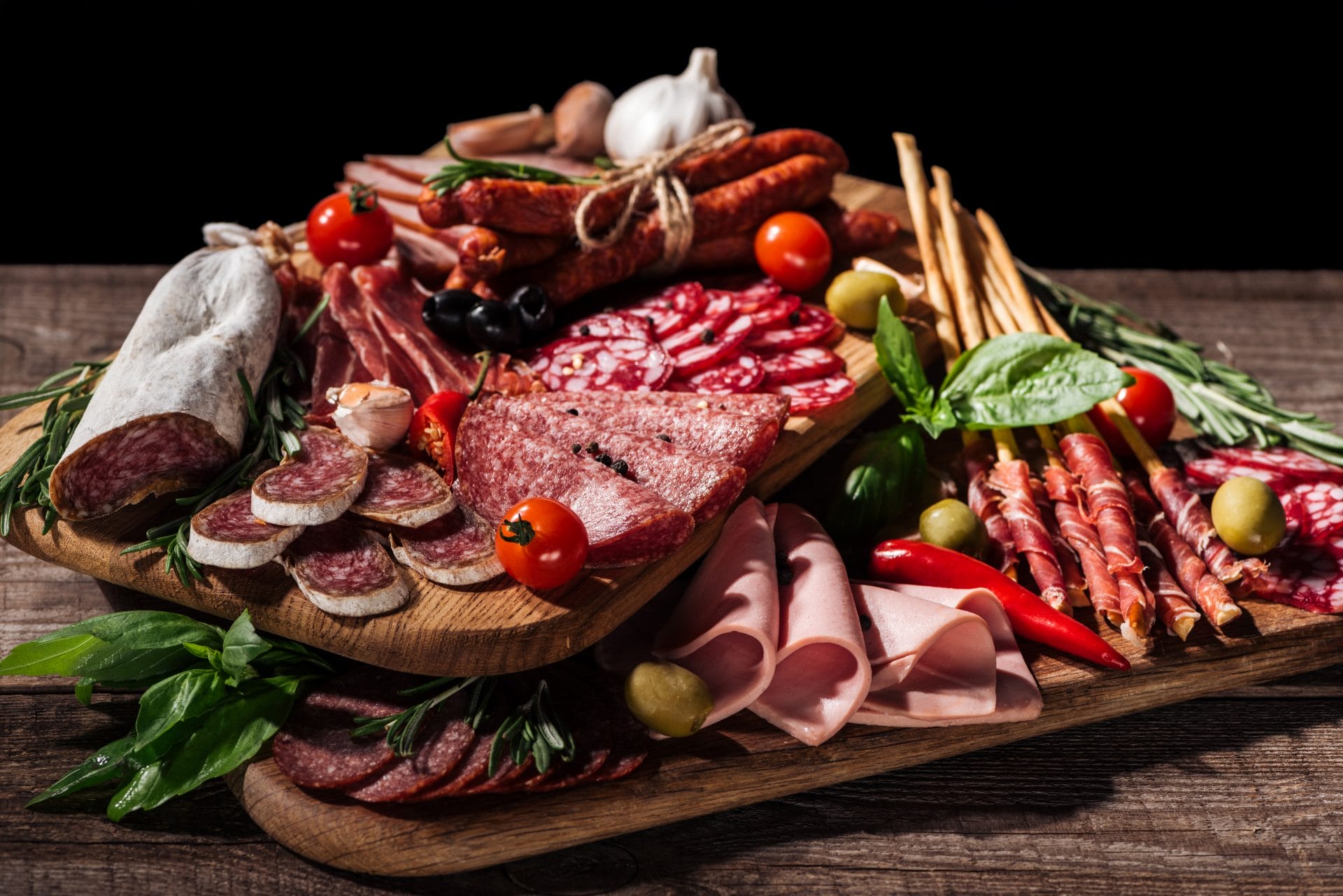
Frequently Asked Questions about Italian Charcuterie Boards
Here are the answers to some burning questions that you may still have:
1. How to Store Leftover Meats and Cheeses?
- Meats: Store leftover cured meats in an airtight container or tightly wrapped in plastic wrap. Keep them in the refrigerator, where they can last for up to a week. For longer storage, consider freezing them, although this may affect texture.
- Cheeses: Wrap leftover cheeses in wax paper or parchment paper, then place them in an airtight container or resealable bag. Store in the refrigerator. Hard cheeses can last up to 3-4 weeks, while soft cheeses should be consumed within a week.
2. Best Practices for Keeping Ingredients Fresh
- Meats: To maintain freshness, keep cured meats chilled until serving. If you plan to leave them out for extended periods, use a chilled platter or an ice pack underneath the serving dish.
- Cheeses: Allow cheeses to come to room temperature before serving for optimal flavor and texture. Keep them covered in the refrigerator to prevent them from drying out or absorbing other odors.
- Accompaniments: Store accompaniments like olives and marinated vegetables in their original jars or airtight containers. Fresh fruits should be added to the board just before serving to prevent them from becoming overripe or drying out.
3. Nutritional Information and Dietary Considerations
- Meats and Cheeses: Italian charcuterie boards can be rich in fats and sodium. Opt for leaner meats and low-fat cheeses if you're concerned about dietary intake. Look for lower-sodium options where possible.
- Vegetarian and Vegan Options: For a vegetarian or vegan board, replace cured meats with plant-based alternatives such as marinated tofu or seitan. Use dairy-free cheeses and spreads to accommodate dietary restrictions.
Troubleshooting Tips
1. Addressing Common Issues
- Dry Meats: If your cured meats are dry, ensure they are stored properly and not exposed to air for too long. Adding a bit of moisture by lightly misting the meat with water or serving it with a side of dipping oil can help. However, if they are too dry, they might need to be replaced.
- Melting Cheeses: Soft cheeses like Mozzarella can sometimes start to melt if left out for too long, especially in warm environments. To prevent this, keep the board in a cool area and serve cheeses chilled if possible. For a more stable presentation, choose cheeses that are less prone to melting.
2. Quick Fixes and Hacks
- Reviving Stale Bread: If your bread has gone stale, refresh it by briefly toasting it in the oven or using a damp paper towel to steam it. This can restore its texture and make it more enjoyable.
- Enhancing Flavor: If cheeses or meats seem bland, try adding a drizzle of high-quality olive oil, a sprinkle of sea salt, or a splash of balsamic glaze to boost their flavor.
- Making a Board Look Full: If your board appears sparse, fill gaps with additional fruits, nuts, or extra garnishes like fresh herbs. This not only enhances the visual appeal but also provides more variety for guests to enjoy.
With these tips and answers, you can ensure that your Italian charcuterie board remains fresh, delicious, and visually appealing, while also accommodating various dietary needs and troubleshooting common issues.
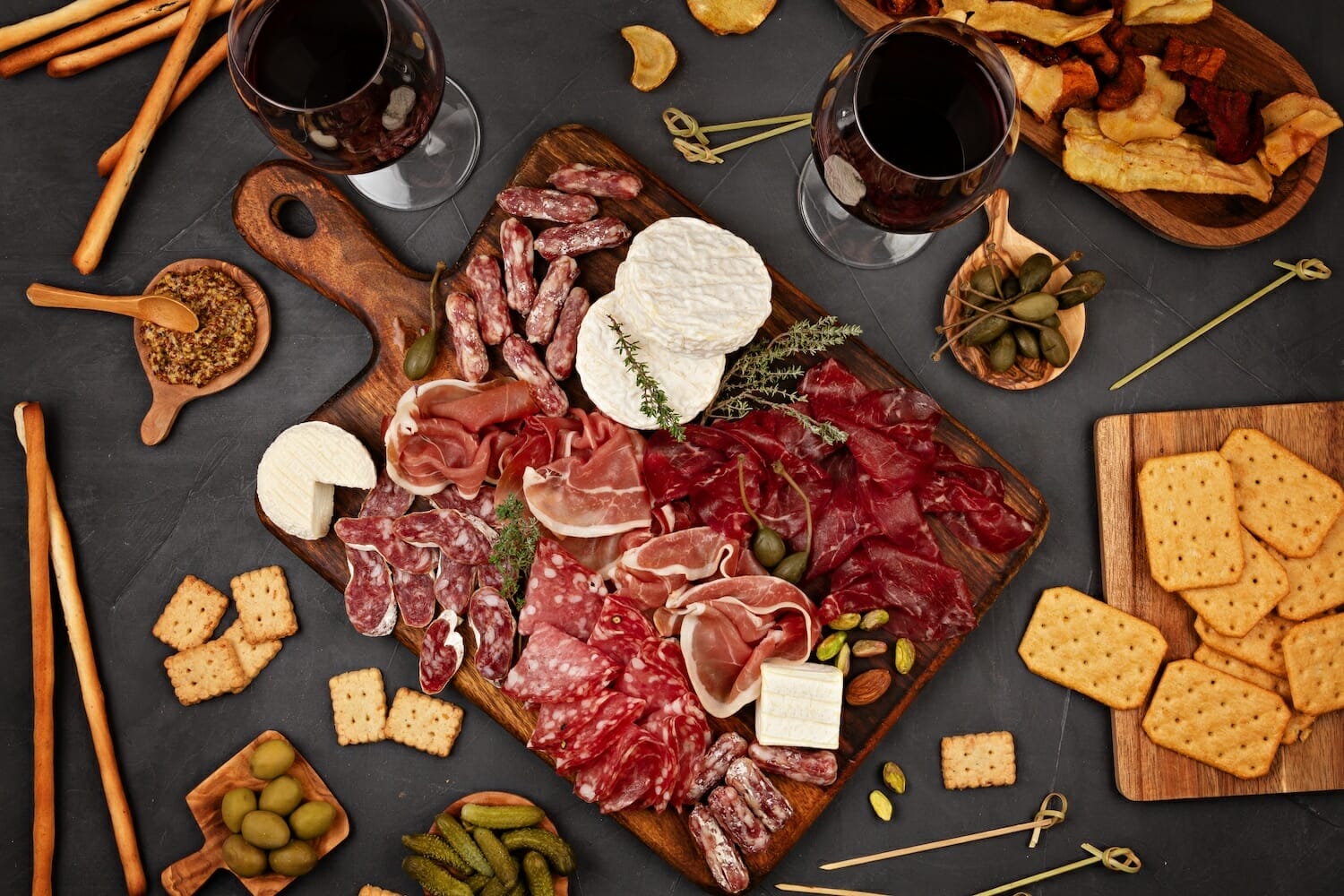
Wrapping It Up
Crafting an Italian charcuterie board combines art and flavor, offering a delightful experience with every bite. From selecting the perfect meats and cheeses to pairing with the right wines and adding creative touches, each step contributes to a memorable presentation. Embrace the opportunity to personalize your board and make it uniquely yours. Share your creations and continue exploring the rich world of Italian cuisine. Enjoy the process and the delicious results!
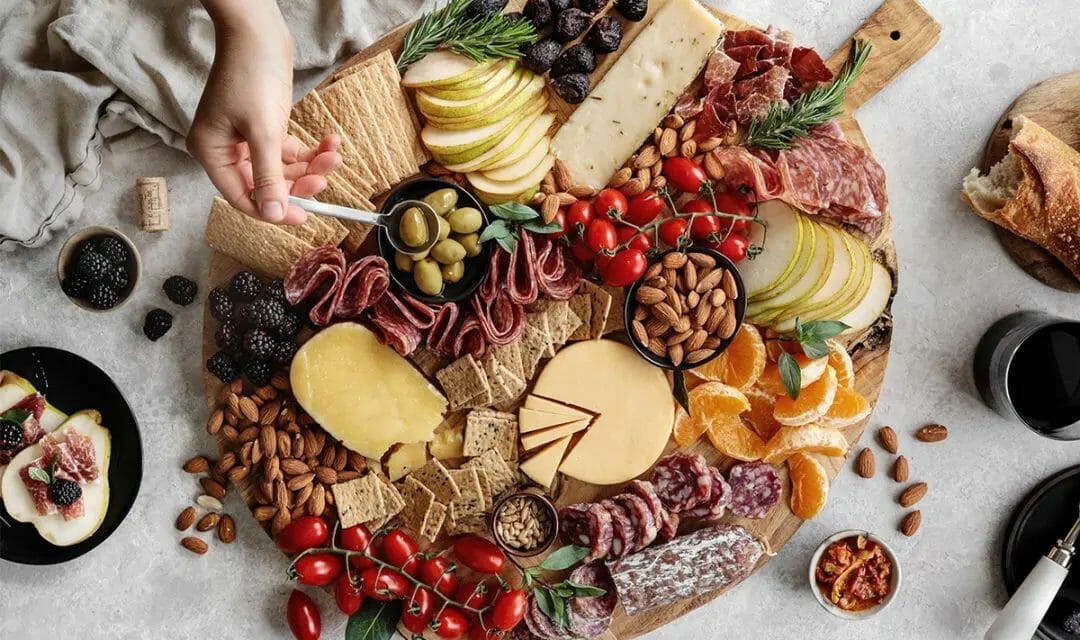
People Also Asked
What should be in an Italian Charcuterie board?
An Italian charcuterie board should feature a variety of high-quality meats, cheeses, and accompaniments. Include Italian classics such as prosciutto, salami, and mortadella, paired with cheeses like Parmesan, Pecorino, and Gorgonzola. Add accompaniments like olives, marinated vegetables, fresh and dried fruits, nuts, and an assortment of breads and crackers. For a touch of authenticity, consider incorporating specialty items like truffle products and balsamic glaze. The goal is to create a balanced and visually appealing spread that offers a range of flavors and textures.
What is the Italian version of charcuterie board?
The Italian version of a charcuterie board is known as an “antipasto platter” or “antipasto board.” This traditional Italian appetizer spread includes a variety of cured meats, cheeses, marinated vegetables, olives, and often bread or crackers. It serves as a flavorful and visually appealing introduction to a meal, reflecting the diverse and rich flavors of Italian cuisine.
What is the difference between French and Italian Charcuterie board?
In Italy, charcuterie is often referred to as “salumi”. This term encompasses a variety of cured meats such as prosciutto, salami, and pancetta, which are integral to Italian culinary traditions.
What do they call charcuterie in Italy?
In Italy, charcuterie is often referred to as “salumi”. This term encompasses a variety of cured meats such as prosciutto, salami, and pancetta, which are integral to Italian culinary traditions.
Share Your Creations:
We’d love to see the charcuterie boards you create using our guide! Feel free to share your own creations in the comments or on social media, and tag us for a chance to be featured. And if you have any other ideas or tips for creating the perfect charcuterie board, we’d love to hear them.







